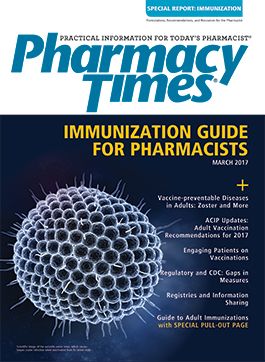Publication
Article
Supplements
Gaps in Immunization Measurement
In the United States, vaccine-preventable diseases cause tens of thousands of deaths each year.
In the United States, vaccine-preventable diseases cause tens of thousands of deaths each year.1 These diseases can lead to poor quality of life, overutilization of health care resources (eg, hospitalizations, emergency department visits), and increased cost to the health care system.2
Vaccine-preventable diseases disproportionately affect elderly individuals and those with chronic illnesses.3 As the US elderly population continues to grow, it is imperative to ensure sufficient adult vaccination rates. However, significant gaps exist between national adult immunization goals and current medical practice. Specifically, Healthy People 2020, a 10-year national plan for improving the overall health of the US adult population, established population health goals for the nation, including benchmarks specific to immunizations.4 Currently, the rates of adult vaccination are below the Healthy People 2020 targets.5 One solution to address this discrepancy has been the development and implementation of quality measures.
The Affordable Care Act ushered in an era of health care reform in the United States, transitioning the health care system from volume to value. This evolution away from a fee-for-service system to new value-based care models has centered on holding health care providers accountable for the care they deliver. Quality measurement has become a fundamental component of these new payment models. Payment for services is increasingly being tied to performance rather than to volume.
With respect to immunizations, Healthy People 2020 has helped prioritize the need for vaccine-related quality measures.4 In addition, the National Quality Forum, a consensus-based quality measure endorsement entity, convened an expert panel to prioritize gaps in immunization measures. The report identified 10 measure gap priorities, which include age-specific priorities (eg, zoster vaccination for patients aged 60-64 years) and composite measure priorities (eg, receiving influenza, pneumococcal, and hepatitis B vaccination as part of diabetes care).6 Additionally, out of the 225 unique measures or concepts identified in the report, a major focus has been on improving influenza vaccinations. Thus, there is an apparent need for measures that focus on all Advisory Committee on Immunization Practicesrecommended vaccines.
Current efforts are ongoing to develop priority immunization measures. For instance, the Pharmacy Quality Alliance has launched an Adult Immunization Task Force (IZ TF). Recognizing the role that pharmacy can play, the IZ TF has been developing measure concepts that align with national priorities, including composite measures that improve adult rates through medication therapy management and a measure that attempts to improve infrastructure by assessing adequate reporting to state immunization registries.
It is important to understand, however, that even with the advent of new measures, a variety of other actions are needed to improve adult immunizations. Such actions include improving vaccine access, education, and infrastructure. Many stakeholders play a role in cultivating the adult immunization system, of which quality measurement is just one piece.
Matthew K. Pickering, PharmD, RPh, is associate director of research & quality strategies, Pharmacy Quality Alliance.Hannah Fish, PharmD, CPHQ, is associate director of education and communications, Pharmacy Quality Alliance.
References
- Thompson WW, Shay DK, Weintraub E, et al. Influenza-associated hospitalizations in the United States. JAMA. 2004;292(11):1333-1340. doi: 10.1001/ jama.292.11.1333.
- McLaughlin JM, McGinnis JJ, Tan L, Mercatante A, Fortuna J. Estimated human and economic burden of four major adult vaccine-preventable diseases in the United States, 2013. J Prim Prev. 2015;36(4):259-273. doi: 10.1007/s10935- 015-0394-3.
- CDC. Vaccine-preventable adult disease. CDC website. cdc.gov/vaccines/ adults/vpd.html. Published December 2016. Accessed February 21, 2017.
- Office of Disease Prevention and Health Promotion. Immunization and infectious diseases: objectives. Healthy People website. healthypeople.gov/2020/ topics-objectives/topic/immunization-and-infectious-diseases/objectives. Updated February 2017. Accessed February 21, 2017.
- Williams WW, Lu P-J, O’Halloran A, et al; CDC. Vaccination coverage among adults, excluding influenza vaccination—United States, 2013. MMWR Morb Mortal Wkly Rep. 2015;64(4):95-102.
- National Quality Forum. Priority setting for healthcare performance measurement: addressing performance measure gaps for adult immunizations. NQF website. qualityforum.org/Publications/2014/08/Priority_Setting_for_Healthcare_ Performance_Measurement__Addressing_Performance_Measure_Gaps_for_ Adult_Immunizations.aspx. Published August 2014. Accessed February 21, 2017.







